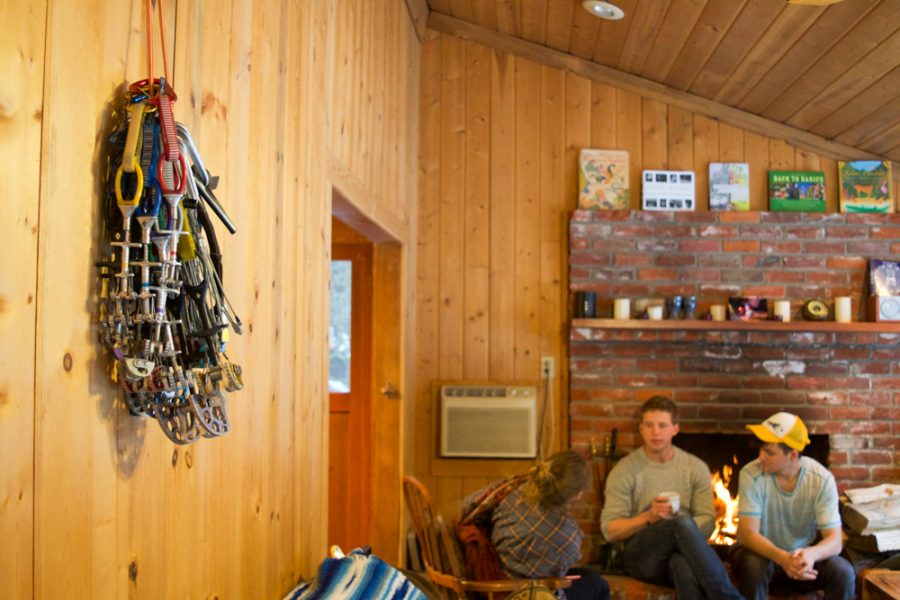Familiar Faces, Strange Places
March 30, 2017
The multi-generational, the secluded, the tiny: enter the living spaces of four Whitman students who call their unconventional dwellings “home.” By upending traditional college living experiences, the students’ insights offer the chance to reconsider how where we live impacts how we live.
‘Caton & Company’: an unconventional family
Just a few blocks from campus, juniors Robby Boyer and Jeffrey Maher reside in a home where they make up two members of ‘Caton and Company.’
The Caton family – Whitman alumni Nick and Julie Caton and their middle school aged daughter, Kaeldra – share their home with Maher, Boyer and two other Whitman alumni – the ‘company.’
As sophomores searching for a place to live the following year, Boyer and Maher first became aware of the possibility of living with the Catons because of their involvement with Whitman’s Renaissance Faire Club. Maher and Boyer, both music majors, participated in the Renaissance Faire for the first time last year through music. Boyer also took part in the club’s annual Murder Mystery dinner.
The Catons are heavily involved in putting on the college’s annual Rennaisance Faire, helping to design costumes, prepare food and more.
But for Maher, President of the Tabletop Games Club, the Catons’ penchant for board games drew him in most of all.
“I wanted to live here because they do monthly game nights the first Friday of the month, and when it’s not an orchestra concert, it’s my top priority,” Maher said.
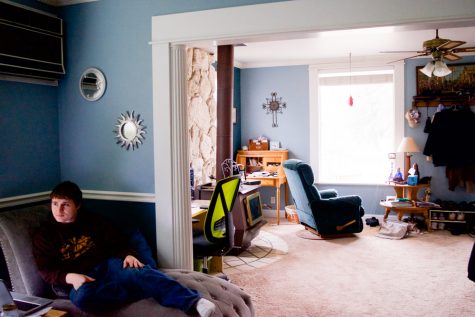
Board games and Renaissance Faire are just two things that bring together the members of the house. Arguably the most important event? Family dinner.
“Coming here was also attractive because I’m on the Caton meal plan, [that’s] what I call it,” Maher explained as Julie yelled half-jokingly from the kitchen not to tell anyone about it.
“It’s a secret, but Nick and Julie cook dinner … and between the two of them they also do all the grocery shopping, so I secretly don’t have to do any work. They’re like my other set of parents now,” Maher said. “That’s very nice because it’s a little transition between having to manage for myself and living off of what Bon App provides for me.”
Beyond dinner, occasionally various house members cook something delicious for the house to share.
“Every now and then someone just feels like making yummy food and there’s some strange thing you’ve never heard of, but it’s really tasty,” Boyer said.
House events, however, are often joined by many more people than the seven that live there. Friends of Julie and Nick, many of whom are Whitman alumni, frequently drop by to join for dinner, game nights and to just hang out.
Maher appreciates the opportunity to connect with previous Whitman students and expand his circle of friends.
“Through [Nick and Julie] I’m in touch with a lot of other alumni who I may have known my freshman or sophomore year, but who graduated and are now spread to the wind,” Maher said. “So I feel like I’m a lot more in touch with them than I would be otherwise.”
For example, Maher participated in a Dungeons and Dragons group with Nick and other alumni, and has become friends with an alumnus working at the Fort Walla Walla Museum.
All of that contributes to a unique feeling of togetherness.
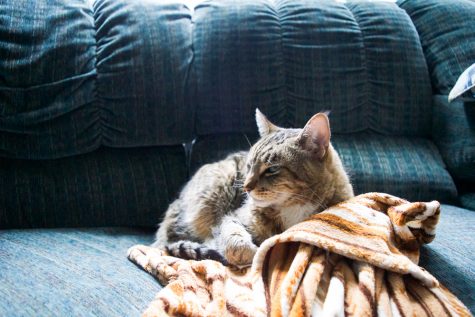
“There’s a nice, also strange sense of family and community in this house that I think is very different from what your normal college community is that I enjoy very much,” Boyer said. “I guess it probably in part comes from the fact that we aren’t all sort of ‘the same.’”
Indeed, the house members — parents, college students, alumni and a middle schooler — are in vastly different stages of life.
Maher and Boyer agree that Julie and Nick are sort of parental figures but also friends.
“They take on all the responsibilities of parental figures but … act like friends. They just happen to make you food. They do all the work of being a parental figure without having to do any of the like not-fun nagging parts of being a parental figure,” Maher said.
Kaeldra, Julie and Nick’s teenage daughter, has become both friend and sister to Boyer and Maher–or “rent-a-sister” as the two say in jest.
All in all, living in a “real” house is much nicer than a dorm or interest house. Maher attributes that in part to the long-term perspective of its owners.
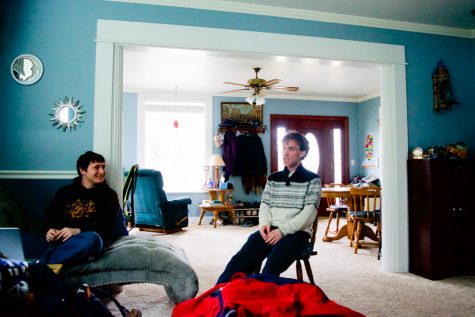
“I think a big part of that’s because Nick and Julie, like this is their house forever, practically, compared to the generation cycle you see in a college-owned house where the longest someone’s going to be living there is probably two years,” Maher added.
“It feels much more like a home,” Boyer said.
“Yeah, a home,” Jeffrey echoed.
Cabin in the woods
To understand how senior Jack Bynum came to live alone in a small cabin in the Blue Mountains about 20 minutes from campus, you have to know a little bit about the vision that Bynum has carried with him since before he came to Whitman.
“I never wanted to go to college,” Bynum said. “Obviously I changed my mind because I ended up coming, but my earliest vision was living in a cabin somewhere in the mountains and going to classes during the day, and living by myself. I was still kind of in my romantic hippie phase and that’s just what I wanted to do.”
Several months into his first year at Whitman, Bynum took a bike ride near Harris Park where he saw a cabin that perfectly matched the one from his vision.
“It was this weird moment,” Bynum said.
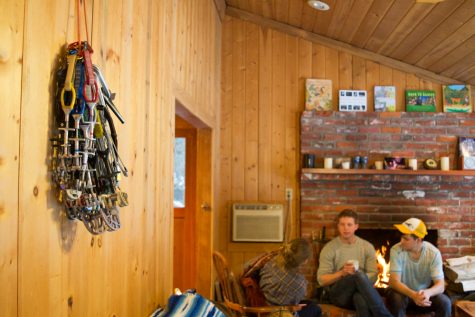
Bynum didn’t end up living in that cabin, and he wouldn’t come to live in his current abode on Kooskooskie Road for another several years. First, Bynum took what he calls his “weird, weird path through Whitman,” which involved a Semester in the West, switching from a politics to an environmental humanities major, studying abroad in Nepal and dropping out several times.
At the beginning of this semester, Bynum had no idea where he would be living, but he knew he wanted to pursue his plan of living in a cabin. So he hopped in his Prius and drove to Klicker’s farm. From Klicker’s, he “knocked on every door between there and Walla Walla.”
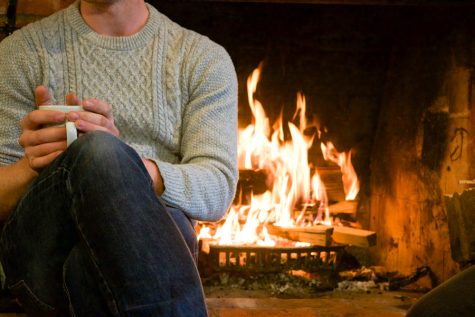
“I talked with folks the whole way back and had tea with like ten people and made lots of nice friends. There’s so many lovely people on this road,” Bynum said.
He ended up finding out about this place through his current neighbor, Cathy. The two have become close since Bynum moved in.
“We’ve become really good friends which is super nice – chatting with her and [having] breakfast together and that sort of thing, which is really lovely,” Bynum said. “When I lived in Walla Walla I actually didn’t know any of my neighbors whatsoever, but now it’s so cool to just have an actual neighbor.”
As for his neighborhood as a whole, Bynum notes the political diversity to be found in the relatively small group.
“Racially it’s not the most diverse but I think probably politically it’s one of the most diverse areas around Walla Walla, if you exclude the Whitman bubble versus the Walla Walla bubble,” Bynum said. “You have leftist hippies right next to hardcore Trump supporters.”
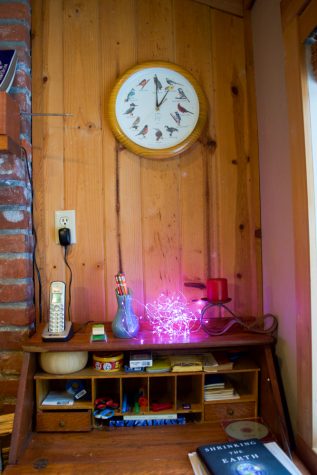
One of the reasons Bynum sought to live somewhat apart from the Whitman community is to avoid getting caught up in the frantic pace of academics.
“I think generally speaking the biggest thing is just removing myself from that all consuming, narrow tunnel that I can get into at Whitman,” Bynum said. “Lots of people don’t get into that tunnel, but for myself, when I’m living close to campus, it’s like I can put all of my heart and soul into every bit of academic work that I could possibly be doing, instead of taking the time in the morning to actually do the things that I need to do to be happy.”
One of these things is simply having space to be alone and recharge.
“It’s really helpful for me to have natural space that is carved out for myself so that when I go to campus and I’m surrounded by people, I can actually really engage with them in a more productive way,” Bynum said.
How has Bynum’s pre-college dream of living alone in the woods changed over the years?
“I think I’m less enamored with the loner in the woods vision than I was when I was pre-freshman I suppose. I think at the time I was very much into the romanticized-individualist-in-the-mountains kind of vision of what peace looked like,” Bynum said. “And now I think there’s a lot of glaring holes in that kind of bullshit.”
For one thing, Bynum finds taking part in a community of neighbors, as in his friendship with Cathy, a simple yet surprisingly rewarding pleasure.
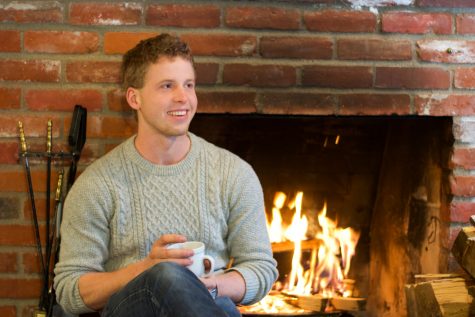
“Just having that community and having people who actually intend to participate in some sort of intentional community and have a vision for what they want that to look like, I think is a really special thing. And it probably isn’t that common,” Bynum said.
Whereas before, Bynum envisioned himself making a principled statement through living in a cabin, today he sees his choice – one he recognizes he has the luxury to make – as part of a greater search for peace.
“Really living up here is not a very romantic thing. It just allows me to be quieter, to be more peaceful. But it’s not like I’m going sauntering through the woods, like Thoreau, you know,” Bynum said.
Indeed, as an avid traveler with a wandering soul – he says he has crossed the U.S. about ten times by various means – Bynum is learning to appreciate staying put.
“I think I’m just starting to see the foolishness of moving all the time. It seems like if there’s anything you can learn in life it’s to learn how to be still,” Bynum said. “And I am not good at that, but I’m trying to be good at that.”
Downsizing: living in ‘The Pantry’
When your room is nicknamed ‘The Pantry,’ you know it isn’t likely to be spacious.
Sophomore Chantal Arnold lives in aforementioned room in the Environmental Awareness House, or the Outhouse, within the Interest House Community.
As an environmental humanities major, Arnold figured the Outhouse would be a good fit for her interests. When it came time to decide which rooms each resident would live in, Chantal ended up with ‘the pantry’ – one of two singles in the house.
“I thought it was cozy and cute, and I liked the little doorway, and the light in my room is a little lantern … I was into it,” Arnold said.
The room’s small size–about 15 by 15 feet–is a significant downsize from Arnold’s previous dwelling on campus. As a first year, she occupied a spacious corner room in Lyman called a ‘dingle’ – a room that’s meant to house two students but ends up having only one.
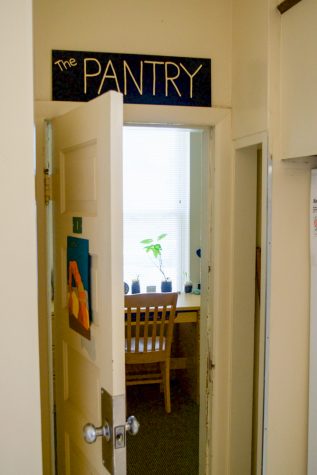
As a small person herself, Arnold feels she’s a good match for ‘The Pantry.’
“I just feel like I fit nicely in the room, because I’m a small person and the room is small, and so all of my things are just small and fit,” Arnold said.
Indeed, Arnold’s room is impressively tidy: floor completely visible and not a stray piece of clothing in sight; even her bed was neatly made. The space may be small, but it doesn’t feel cramped or confining.
Arnold said the room’s limited space goes a long way in helping her keep everything organized.
“My favorite part is that it’s really easy to keep clean, because everything has a spot,” Arnold said.
More than that, residing in ‘The Pantry’ has brought to Arnold’s attention how much space she can comfortably live in.
“I think it just opened my mind to the amount of floor space and living space I actually need as a person, and so now I’m just like more aware of the space that I do take up,” Arnold said.
The room’s proximity to the kitchen, while consistent with its moniker as an area for food storage, keeps Arnold in the loop of her housemates’ activities.
“I like it being right off the kitchen because I can hear what’s going on, and I’m a fairly social person with my housemates so it’s fun to be a part of whatever is happening,” Arnold said.
However, Arnold believes the room’s probable former role as a pantry explains its unusual sensitivity to temperature changes.
“I don’t think the room was ever meant to be a room, so it gets very cold when it’s cold outside and it gets very hot when it’s hot outside. So I don’t think there’s a lot of insulation in the walls, because it was probably meant like to be a pantry, or like a cellar or something like that,” Arnold said.
Whatever role the room once filled, it’s clear that it’s now a place to call home.
“Just being in a house, it’s a little more homey than in Lyman, where it felt like I had a mini-apartment,” Arnold said. “Now it feels like I have a room in a house and a community, so that’s nice.”


